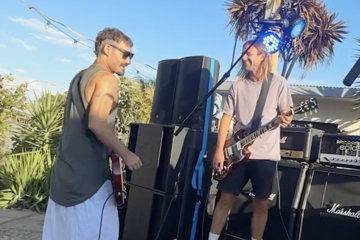Can ‘Big Little Lies’ Star Shailene Woodley Stop ‘Adrift’ From Sinking?
"Viewer confusion never allowed to take root."
ADRIFT

In 1983, when Tami Oldham found herself alone, adrift in a sinking ship, in the middle of the Pacific Ocean, it must’ve seemed unbelievable, like a waking nightmare. 35 years later, someone in her position might look around at the empty expanse of ocean, and think of all the times they’ve seen it on screen. The ‘survival’ genre is, by this point in human history, firmly entrenched; audiences filing into multiplexes to see tiny figures battle against vast expanses of unfriendly nature, kept safe in the knowledge that, as survivor’s tales, the subject at the centre of these movies will duly overcome the odds, live on to tell their story.
Baltasar Kormákur has, after a career of hopping between Iceland and America, oft making crime-thrillers as he’s gone, almost settled on survival as his cinematic corner. 2012’s The Deep re-told the true tale of Guðlaugur Friðþórsson, an Icelandic fisherman who survived for six hours in freezing waters after his boat capsized. 2015’s Everest depicted the 1996 Mount Everest disaster, its marriage of in-built mountaintop branding, widescreen imagery, high drama, and celebrity ensemble leading to box office success.
Don't miss a beat with our FREE daily newsletter
Now comes Adrift, in which Oldham’s memoir Red Sky In Mourning: A True Story Of Love, Loss, And Survival At Sea is brought to screen with Shailene Woodley, Sam Claflin, and endless stretches of Pacific Ocean. The film opens in the moment of discovery: Woodley coming-to in the wake of a hurricane, the boat she’s on sinking. From there, things proceed in dual narrative, setting our heroine’s survival in the present against a falling-in-love narrative staged in the past. Slowly, but surely, they merge: the dramatic storm lingering inexorably on the horizon in one narrative, whilst we reel in its wake in the other.
The film, in turn, gives equal weight to its twin narratives. This isn’t just a survival story, in conception or delivery. Instead, it’s part survival movie, part romance. When Claflin sails into frame, handsome and bearded, there’s at once a romantic frisson and a sense of sinking dread: this’ll be the man who’ll lead Woodley to her boat-in-ruins.
They play a pair of wanderers. She’s a go-getting free-spirit who won’t bother to look before she leaps (literally: see her jump into a swimming hole, with due symbolism), five years deep into leaving behind whitebread San Diego to go wandering the globe, wherever the wind blows. He’s an English sailor; a little older, more pensive, on the run from a tragic childhood as he sails the seven seas. Their whirlwind courtship is the stuff of travel-brochure inspirationalism: Pacific islands, fruit platters, thatch-wood bars, hikes to waterfalls, postcard sunsets.
Woodley’s grim battle for survival, however, plays like a YA-friendly, sub-par riff on All Is Lost. Where J.C. Chandor’s film steered into the silence of being alone on an ocean, here Woodley offers a running commentary on what she’s doing; with Hauschka’s score accompanying her all the while. The nadir of this spoken-aloud tendency comes when she wonders aloud, very obviously, “am I hallucinating?”; viewer confusion never allowed to take root.
The elemental literalism of the film is echoed by the two pop-songs placed herein. Emilíana Torrini covers Tom Waits’ I Hope That I Don’t Fall In Love With You, with the final line — “And I think that I just fell in love with you” left lingering, tellingly. On close, Waits’ Picture In A Frame plays over the credits, signing us off with “I love you baby and I always will”; the big emotions of the film all but underlined by the songs, the desire to make this as much love-story as survival-movie sounding out loud.
MARY SHELLEY

God, biopics. They’re the worst. Mary Shelley’s to-screen depiction of its eponymous heroine plays things safe and tasteful, delivering a non-threatening portrait of scandalous passion for a Sunday-afternoon arthouse crowd. Based on a script by Australian screenwriter Emma Jensen, Haifaa al-Mansour’s film is mired in convention; doubly disappointing given it marks al-Mansour’s English-language debut, and that its lead performance marks maybe the least-interesting in Elle Fanning’s career.
Here, Mary is depicted as the original Goth girl, luxuriating in a host of lovely frocks and blouses, posing in every scene as if situating herself in some ongoing Instagram feed. When your approach submits one of the most electric young actors in the world —Fanning’s recent turn in How To Talk To Girls At Parties is another amazing performance— to something stilted, stiff, and mannered, it’s a pretty clear sign that the starched period-piece approach to biopicdom should be set ablaze.
Instead of exploring, say, Frankenstein as an ur-text first manifestation of body-horror, a work inspired by pregnancy and miscarriage, here’s another film about women enflamed by scandalous passions and the mutton-chopped men who inspire them. There’s poetic voice-over, actual poems read aloud, drawing rooms, dappled sunlight glinting through trees, strings swelling in moments of passion, some tasteful fucking, and rain running down windows in down moments; the tone kept prim and proper whilst the drama is, essentially, soap-opera.
And, as always, moments of artistic inspiration are depicted with a complete lack of it. When Frankenstein —one of the most influential texts in human history— is written, al-Mansour cooks up a montage where shots of our heroine writing are matched to misty water-colour memories of things we’ve already seen in the story; the essential effect being like a clip-show for the movie we’ve just watched.
BACK TO BURGUNDY

Sadly, Back To Burgundy isn’t a sequel to Peter Strickland’s domestic-doms neo-classic The Duke Of Burgundy (there’s not a human toilet in sight!). Instead, Cédric Klapisch —who’s been trading in French art-house fluff for a quarter-century— peddles a far more familiar narrative, and plenty of good old-fashioned crowdpleasery. Pio Marmaï plays the black-sheep son who, after years away (in Australia!), returns to the old family home following the death of his father. Befitting these back-home dramas, he and his once-estranged siblings (Ana Girardot and François Civil) hash out all their feelings about dead-dad and the familial dynamic. The obligatory old-family-skeletons come tumbling out of the closet, before wounds heal, siblings bond anew, and the ol’ home becomes a Home.
Klapisch makes the movie a modest success by matching all these familiar fam-drama beats to the seasons, which serve as natural narrative markers. Shooting on an estate owned by actor Jean-Marc Roulot, Back To Burgundy settles on the Earth of the property, amongst the rows of vines. It’s far more successful in its depictions of the winemaking process than it is in coming up with a unique take on adult-sibling relations (and their attendant childhood flashbacks). In fact, the montages of wine being made are so many and so measured that they feel almost instructional. So, for the oenophiles in the audience, there’s an added layer of crowdpleasin’ on top of the rote dramatic crowdpleasery.
THELMA

In Joachim Trier’s Thelma — screening at Palace’s upcoming Scandinavian Film Festival — a teenage girl discovers the ultimate super-power: same-sex attraction! Our titular character (Eili Harboe) has been raised beside a frozen-lake in some snowy Norwegian outpost, fussed over by obsessive, way-Christian helicopter-parents. Except, an opening sting — where bearded pops considers shooting his child, back in her blondest years of innocence, but can’t go through with it — suggests that all’s not right with daughter-dear; these anxious parents operating out of fear that they’ve given birth to a monster. Thelma leaves the nest to go to college in Olso, where, amidst the teeming masses and grand-scale buildings, she feels lost, tiny, insignificant. When she meets Anja — played by the lo-fi singer-songwriter Okay Kaya, whose jam IUD you should just go listen to — repressed passions/super-powers come to the fore.
This sounds silly, or, even worse, pandering to popcorn-cinema’s all-conquering genre, but keep in mind who’s making it. Trier’s prior filmography includes the incredible Oslo, August 31st, and even the supposed ‘misstep’ of his English-language family-drama, Louder Than Bombs, was plenty impressive. Working, again, with co-writing collaborateur Eskil Vogt, he hits the right tone: depicting this supernatural drama with a cold, quizzical remove; big teenage emotions trapped within meticulous-framing, or dwarfed by grand architecture and eye-of-God overheads.
Trier also fudges the reality of Thelma’s supernatural experiences: does she really make the Earth shake, the air tingle, crows flock to her, people to disappear? Or is this all a delusion, a hallucination from psychogenic non-epileptic seizures? When she’s subjected to a battery of tests at an epilepsy centre (strobe warning!), it’s a sequence of brilliant photography that, simultaneously, feels like an interrogation of genre concepts. Throughout, Trier uses such moments of visual storytelling to deliberately muddy the supernatural waters, playing with familiar tools of disorientation: dream-sequences, hallucinations, surrealism. The ‘reality’ of Thelma is forever fluid, shifting, but its moral clarity remains rock-solid. Here, father-knows-best patriarchy is holding back a girl, repressing her true nature via self-abnegating prayer and doses of mind-numbing pharmaceuticals. But, beckoning, clear and true through the chaos of self-discovery, is the key to unlocking her full potential: queer love.







